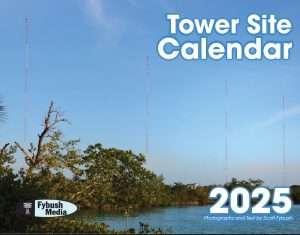Site of the Week 8/27/2021: KDKA at 100
Text and photos by SCOTT FYBUSH
Originally published Nov. 6, 2020 – but we present an encore this week as we catch up to our November 2020 travels in chronological order! We’ll be back with a new Site of the Week installment Sept. 3.
As the calendar rolled around to “Nov. 2, ’20,” there really wasn’t any question in our mind about where we needed to be: at the spots where broadcast history was made on “Nov. 2, ’20,” a century ago in 1920.
No, KDKA wasn’t the very first broadcaster to do most of the things that led the history books to enshrine it as the “first radio station” – there were others, even before 1920 in some cases, offering scheduled programs, reporting election returns, and providing some semblance of commercial operation.
But KDKA still mattered, then and now, because unlike most of its historical cohort (8MK/WWJ in Detroit, San Jose Calling/KQW/KCBS out west, 9XM/WHA in Madison, XWA/CFCF in Montreal), it was part of a big corporation with an energetic public relations department that understood from the beginning that it was promoting the start of something new and important.
In short, at least the way we’d summarize it: while KDKA may not have given birth on its own to “broadcasting,” it was where the broadcasting industry first took form.
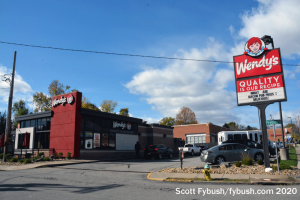
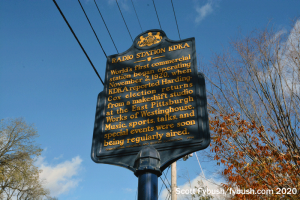
After listening to KDKA launch its second century with the addition of an FM translator (W261AX at 100.1) at the start of its morning show on Monday, we set out to do a circuit of all the sites from which the station has broadcast, even though we knew we wouldn’t see much at the first two.
One of the great tragedies of American broadcast facility history was the demolition back in 2001 of the spot where KDKA was conceived.
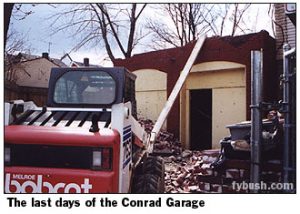 Frank Conrad, the brilliant Westinghouse engineer who’s credited with building the station, did his early radio experiments from the top floor of a brick garage behind his stately home in Wilkinsburg, a few miles east of Pittsburgh.
Frank Conrad, the brilliant Westinghouse engineer who’s credited with building the station, did his early radio experiments from the top floor of a brick garage behind his stately home in Wilkinsburg, a few miles east of Pittsburgh.
The house and garage survived for more than 80 years after Conrad converted his amateur station, known as 8XK when it was in his garage, into commercially-licensed KDKA. (The story goes that he was on standby in Wilkinsburg to fire up his transmitter at home if the new KDKA transmitter wasn’t ready on that first November night; in any event, that first broadcast also used the amateur experimental call 8ZZ because the official KDKA license hadn’t arrived yet.)
And then, in 2001, the property in Wilkinsburg was sold – which is why if you go looking for that most historic of historic spots today, you’ll find yourself at the corner of Penn and Peebles Avenue in the back parking lot of a Wendy’s. (Which is also why a bunch of puzzled Wendy’s drive-through customers were wondering why your intrepid historian was standing in the lot taking pictures on that historic centennial day.)
The bricks from the Conrad garage were saved during the demolition, with hopes of rebuilding the structure somewhere else, but that’s been 19 years now, and we wonder if they’re even still intact.
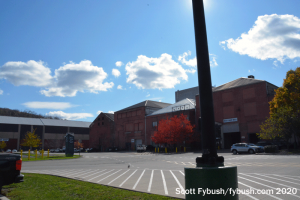
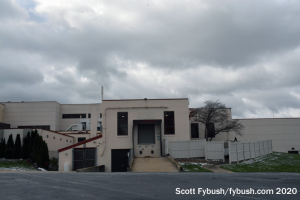
There is, sadly, also very little left of the equally historic location where that November broadcast actually happened. Both the makeshift studio/transmitter shack and the wire antenna were on the roof of Building K, the tallest structure at Westinghouse’s East Pittsburgh factory. It stood until 2007 before being demolished to create space for parking for Keystone Commons, the industrial park that took over the old Westinghouse space after it was vacated.
There’s a historical marker at the entrance to the parking lot, and if that’s as close as we could get to the exact spot on which to commemorate the centennial, so be it – we took our (socially distanced) selfies and moved on.

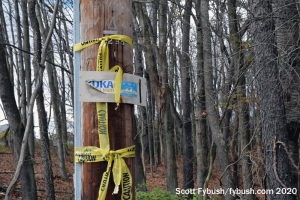
KDKA moved on, too: as power levels increased, the roof of an active factory building quickly became impractical for a high-powered broadcasting facility. KDKA moved its studios downtown to the Grant Building, and relocated its transmitter to a site in Forest Hills, just north of East Pittsburgh.
But high-powered AM and urban settings didn’t mix well back in those days of radio receivers with poor selectivity, so in 1929-1930 KDKA built a new transmitter site way up north of Pittsburgh in Saxonburg, just across the Butler County line.
At this site, Westinghouse began experimenting with shortwave and very high power AM. As with many sites from this era, it proved to be just a little too far from the city, though – and so KDKA moved once more in 1937, a dozen miles back south on Route 8 to Allison Park, northeast of downtown Pittsburgh.
Both the Forest Hill site (now the Westinghouse Lodge rec center) and the Saxonburg building have survived; we were especially interested in Saxonburg, where the imposing brick building along Saxonburg Boulevard lived on with shortwave transmissions for a short time after the AM station moved (the shortwave transmitters were later relocated to sister station WBZ in Hull, Massachusetts), before the site was donated to the Carnegie Institute of Technology for its nuclear science program. Today, the site belongs to the II-VI Corporation’s manufacturing plant – but look closely at the front of their big building and you can clearly see the original 1929 structure!
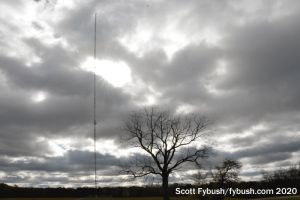
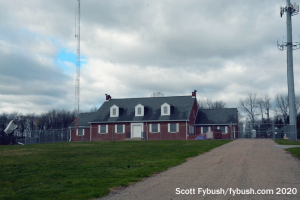
After all that moving around, KDKA stayed put at its new Allison Park home, where its new Westinghouse-built transmitter served for four decades before giving way to newer models. (See a full tour of this site from 2009 here.)
KDKA also found studio stability: in the early 1950s, it moved from the Grant Building to the new Gateway Center development right at the point in downtown Pittsburgh, and it stayed there until 2010, when CBS Radio (the new name for what had been Westinghouse/Group W after it acquired CBS in 1995) moved its stations to suburban Green Tree. (See the current KDKA studios in this 2013 Site of the Week installment.)
So we salute you, KDKA, on your contributions to broadcasting – and we look forward to being able to have more social celebrations as more pioneering stations such as WBZ, WABC, KYW and others get ready to mark their centennials in the next few years!
One more thing we’d have done in non-pandemic times (and on a day that wasn’t right before election day, when we were needed in the newsroom back home): we’d have continued south and east from Pittsburgh to witness another bit of broadcast history. On Wednesday morning, Nov. 4, the four towers that carried Washington’s WMAL (630) from 1941 until 2018 were taken down. We chronicled that site in detail a few years ago, and you can see that Tower Site of the Week installment here.)
SPRING IS HERE…
And if you don’t have your Tower Site Calendar, now’s the time!
If you’ve been waiting for the price to come down, it’s now 30 percent off!
This year’s cover is a beauty — the 100,000-watt transmitter of the Voice Of America in Marathon, right in the heart of the Florida Keys. Both the towers and the landscape are gorgeous.
And did you see? Tower Site of the Week is back, featuring this VOA site as it faces an uncertain future.
Other months feature some of our favorite images from years past, including some Canadian stations and several stations celebrating their centennials (buy the calendar to find out which ones!).
We still have a few of our own calendars left – as well as a handful of Radio Historian Calendars – and we are still shipping regularly.
The proceeds from the calendar help sustain the reporting that we do on the broadcast industry here at Fybush Media, so your purchases matter a lot to us here – and if that matters to you, now’s the time to show that support with an order of the Tower Site Calendar. (And we have the Broadcast Historian’s Calendar for 2025, too. Why not order both?)
Visit the Fybush Media Store and place your order now for the new calendar, get a great discount on previous calendars, and check out our selection of books and videos, too!
And don’t miss a big batch of Pittsburgh IDs next Wednesday, over at our sister site, TopHour.com!
Next week: Butler County, PA

